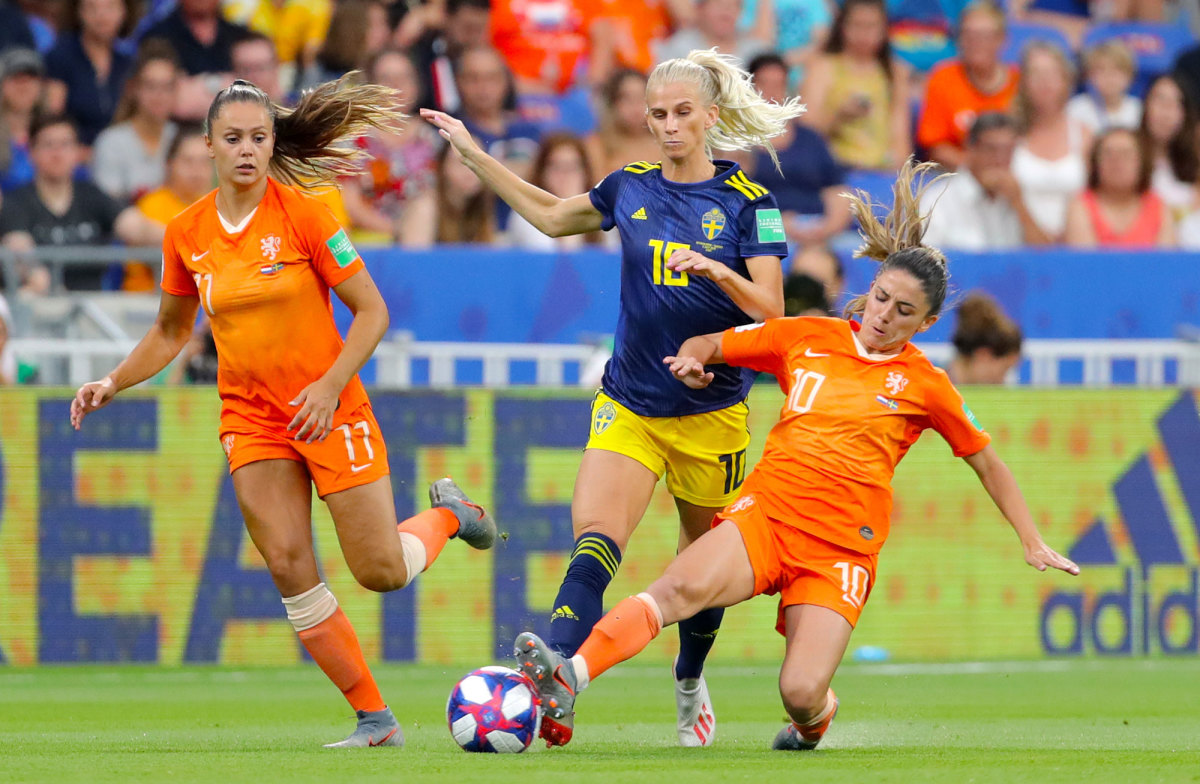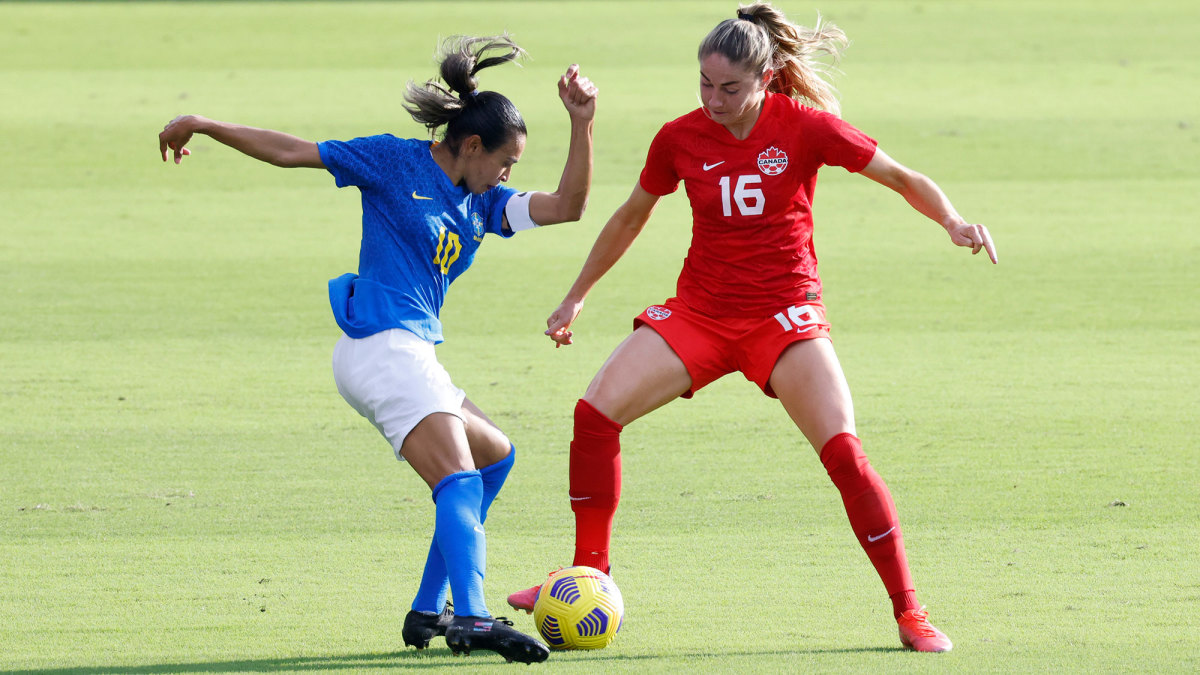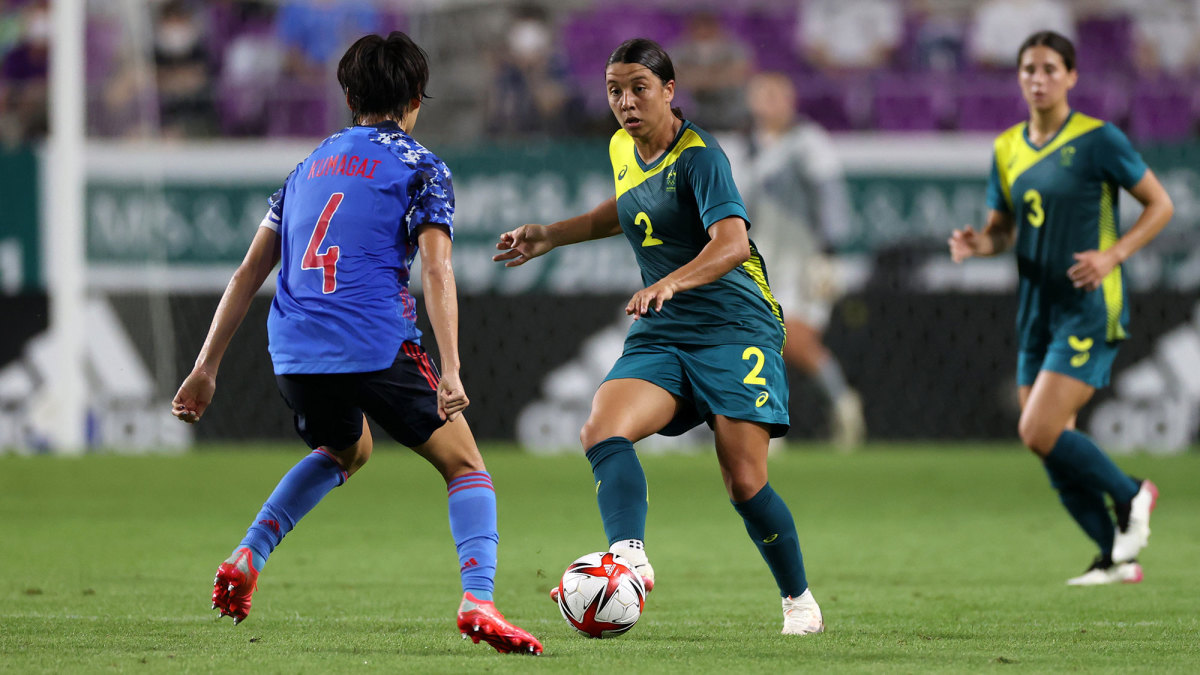The Top Threats to the USWNT's Quest for Olympic Gold

Set your alarms and keep the coffee at the ready.
The Olympic women’s soccer tournament begins Wednesday in Japan, with Great Britain vs. Chile kicking off at 3:30 a.m. ET as the first of six group-round games that day. The U.S. follows an hour later with its opener vs. Sweden, and additional group matches on July 24 and July 27 will precede the knockout rounds, with an eventual gold-medal match taking place on Aug. 5 (it’ll Aug. 6 in Tokyo).
The tournament features 12 teams, with the FIFA world No. 1 USWNT being widely considered the favorite. The U.S. has not lost since a road defeat to France in January 2019 (44 matches), and it’s attempting to become the first reigning Women’s World Cup champion to win the subsequent Olympic gold medal (not to mention, aiming to avenge its shocking Olympic quarterfinal exit five years ago).
The road to the podium, however, will not include a couple of familiar heavyweights. France, the world’s No. 3 ranked team, will not feature in Japan because of European qualification rules (the confederation’s three Olympic spots went to the three countries that finished highest at the ’19 World Cup), and No. 2 ranked Germany won’t have a chance to defend its 2016 gold medal for the same reason. Spain, a rising threat in the women’s game, won’t be there, either, after its round-of-16 exit to the U.S. two years ago.
Despite those absences, intrigue still abounds as the rest of the world tries to knock the U.S. off its perch. And if you’re a fan of chaos and underdogs, consider that if the USWNT doesn’t win gold, we are guaranteed to get a first-time women’s Olympic champion. The tournament groupings are as follows (Groups A-D are part of the men’s tournament, which kicks off Thursday):
Group E: Great Britain, Canada, Japan, Chile
Group F: Netherlands, Brazil, China, Zambia
Group G: United States, Sweden, Australia, New Zealand
Who should U.S. fans be most concerned about? We break down the seven teams most likely to stand in the way.

Top threats
Netherlands
FIFA world ranking: 4th
The U.S.’s 2019 final opponent is lurking again in these Olympics. The Dutch should be regarded as the favorite to win Group F, and doing so could put them on another championship collision course with the U.S. (should both countries win their respective groups, they would be on opposite sides of the knockout bracket). The Netherlands is led by Arsenal’s Vivianne Miedema, one of the world’s premier strikers at age 25, as well as Barcelona forward Lieke Martens, Manchester United midfielder Jackie Groenen and PSV goalkeeper Sari van Veenendaal, the last of whom gave the U.S. fits in said World Cup final. The U.S. successfully kept Miedema and the Dutch attack in check in that game, but she’ll be a major key to any gold medal push this team makes in Japan.
Generally, scoring isn’t a problem for the Netherlands. The Dutch can put up goals in bunches and have tallied some eye-popping results in 2021, pummeling Australia 5–1, Belgium 6–1 and Norway 7–0. But 1–0 defeats to Italy and Spain, as well as a 2–0 loss on home soil to the United States last November (a game that had key absences on both sides, including Miedema), show they are still trying to get over that final hurdle since bursting onto the scene by winning the Women’s Euros in 2017.
This tournament is also a sendoff for Dutch coach Sarina Wiegman, who has brought this federation to the cusp of global glory and is taking the England women’s job in September. Ending her tenure on a high, though, may require putting the type of offensive pressure on the U.S. that they’ve failed to do in the sides’ last two meetings. That starts in the midfield, where Groenen, Lyon’s Daniëlle van de Donk and others will play a pivotal role in any Olympic run.
Sweden
FIFA world ranking: 5th
The Swedes are one of just two teams since April 2019 that have played the U.S. and not lost (the other, South Korea, is not at these Games). Three months ago, the USA needed an 87th-minute penalty kick by Megan Rapinoe to salvage a 1–1 draw in Stockholm. They’ll meet again on Wednesday in a sneaky-critical opener for both sides—the victor, should there be one, will have the inside track at winning Group G, which comes with the award of avoiding a scary quarterfinal matchup (Group G’s second-place team will draw the winner of Group F, very likely to be either the Netherlands or Brazil. The Group G winner will face a third-place finisher in the quarters).
A number of the Sweden players who were on the 2016 Olympic roster when it stunned the U.S. are back, including star center back Magdalena Eriksson, midfielder Kosovare Asllani, forwards Sofia Jakobsson and Fridolina Rolfö and captain Caroline Seger. This group shouldn’t be intimidated by the prospect of facing the U.S.—or anyone else—and if there’s a silver lining to opening with such a high-profile match, it’s that there can’t be a rematch until the final.

The next tier
Brazil
FIFA world ranking: 7th
Two former USWNT head coaches will be on other sidelines in Japan—Brazil’s Pia Sundhage is one, and New Zealand’s Tom Sermanni is the other. Sundhage, of course, famously won gold while coaching the U.S. at the 2012 Olympics in London, then stepped down and took the job in Sweden, where she managed the 2016 team that knocked out the U.S. in the quarterfinals. In 2019, she took over for Brazil and now leads an intriguing group looking to cause some real damage at the Tokyo Games.
In the last decade-plus, Brazil has struggled to replicate its women’s soccer golden days, when it was runner-up at both the 2007 World Cup and 2008 Olympics, and when Marta—now 35 and still a very good player—was at her incredible peak. But there’s plenty of talent here in 2021, and under Sundhage, this group has evolved into one on the upswing. Marta is still here, of course, and amazingly so is 43-year-old Formiga, who has played in every single Olympics that has had women’s soccer (since 1996) and is making her seventh(!) trip.
The title of Brazil’s top playmaker now, though, belongs to Debinha, a dynamic midfielder who stars in the NWSL and is a scoring threat whenever she approaches the 18-yard-box. Brazil will need her at her best in its quest for a medal. This group did see the U.S. earlier this year, losing 2–0 at the SheBelieves Cup (it beat both Canada and Argentina by multiple goals in its other matches in the event). Brazil had its chances against the U.S. and will need to be more clinical if it’s to break through in Japan, starting in a crowded Group E.
Canada
FIFA world ranking: 8th
Could we get a U.S.-Canada meeting at a major tournament for the first time since that instant classic at the 2012 Olympics? It’s certainly a possibility, with Canada right in the mix again for a medal and a number of potential paths to these sides meeting in the knockouts. The Canadians gave the U.S. a ride at the SheBelieves Cup in February, holding the hosts scoreless for 78 minutes before a Rose Lavelle goal proved to be the difference. And while Canada left that event having scored only once, it was playing its first matches under new head coach Bev Priestman.
Priestman hasn’t had a lot of time to implement her vision on the team ahead of the Olympics, but there have been some encouraging results. Canada beat England 2–0 on the road in April, tied Brazil 0–0 in June and drew with the Netherlands 3–3 last week in a pre-Olympic training match.
The roster is a mix of experience—like all-time international goal-scoring leader Christine Sinclair (38 years old) and a player with 205 caps in Sophie Schmidt (33)—and youth, like standout defender Ashley Lawrence (26) and midfielder Jessie Fleming (23) and promising young forwards Jordyn Huitema (20) and Evelyne Viens (24). The big question for Canada, though, is a familiar one: Can this team score enough? With a variety of attacking options—which also include Janine Beckie and Nichelle Prince—Priestman is hoping to find the right mix that gives Canada the clinical finishing it needs to get on the podium.
Great Britain
FIFA world ranking: 6th (for England; however, Great Britain could also pull from the rosters of Scotland, Wales and Northern Ireland)
In certain ways, Team GB is a bit of a mystery heading into this Olympic tournament. The England team that pushed the United States to the brink in the 2019 Women’s World Cup semifinal has taken multiple steps back in the two years since, winning just three of the nine friendlies it’s played and most recently falling to France and Canada by an aggregate score of 5–1. Meanwhile, manager Phil Neville moved on to MLS, and Hege Riise has taken the reins (including those of Team Great Britain) until Wiegman arrives in September.
Many of the England players who were on that 2019 team are now part of Team GB, and only three of its 22 players (Scotland’s Kim Little and Caroline Weir; Wales’s Sophie Ingle) are from outside that federation. So the concerns around England’s recent form are real, as is the fact that Great Britain will enter its opener having scarcely played together (a scheduled July friendly with Zambia was canceled, but it did recently beat New Zealand 3–0 in a closed-door Olympic warm-up friendly).
Perhaps of chief concern is the Team GB defense, as England posted just two clean sheets (vs. 30th-ranked Portugal and 48th-ranked Northern Ireland) in its last 11 official games. The defender list is familiar, including The Best FIFA Women's Player honoree Lucy Bronze at right back and Millie Bright, Steph Houghton and Leah Williamson at center back, but that group hasn’t always proven to be the most effective unit at the international level, particularly on set pieces. Look for the talented 24-year-old Williamson, of Arsenal, to have a larger role this time after barely appearing at the ‘19 World Cup.
In the attack, Team GB definitely has the pieces to be dangerous, including Ellen White, Fran Kirby, Nikita Parris, Georgia Stanway and promising 20-year-old Lauren Hemp. Kirby is coming off a brilliant season with Chelsea, while White starred two years ago in France. Still, Team GB will need to gel quickly to succeed in a tricky group and avoid falling behind the eight ball—or worse, missing the knockout phase entirely.
Japan
FIFA world ranking: 10th
The host side has been building toward this Olympic tournament for some time, sacrificing experience for youth at the ’19 World Cup to rebuild for the future. Those growing pains were still on display at the 2020 SheBelieves Cup, when Japan lost all three games just before the COVID-19 pandemic shut down sports, and it’s only played five friendlies since. The good news: it dominated four of those matches by a combined score of 27–1, and won the fifth, 1–0, over Australia. The bad news: The average FIFA ranking of the non-Australia opponents is 42.3, so those routs are largely not indicative of the quality of team it will face in these Olympics.
While this is a young group, not everyone on this Japan roster is inexperienced on the big stage. Mana Iwabuchi, 28, has been on the scene since the 2011 Women’s World Cup, and the creative forward has scored six goals across the five 2021 matches. Captain and 30-year-old Saki Kumagai, meanwhile, was a stalwart at Lyon and is an anchor of the Japanese defense.
With a lack of high-quality games to go on, it’s hard to gauge exactly what to expect out of Japan in these Games, but make no mistake: It has its eyes on the podium, including a push for gold. Group play will be critical, with Japan, Canada and Great Britain all conceivably able to finish anywhere from first to third. The difference in placement is steep and will largely shape who is most likely to advance past the quarterfinals.

The wild card
Australia
FIFA world ranking: 9th
On paper, The Matildas are a perfectly solid team. They have one of the best strikers in the world in Sam Kerr, who is always a threat to score so long as her teammates can get the ball to her feet (or head). They have a team filled with players with major (and varied) club experience, ranging from the NWSL to the WSL to the local W-League. And of the 18 players on the initial Olympic roster before it expanded to 22, only one (Kyra Cooney-Cross) is making her debut on a major tournament roster.
The problem? For one thing, Australia is on its third head coach since 2019, and the turnover—on top of the pandemic—has taken its toll. Interim coach Ante Milicic managed the team at the 2019 World Cup and was intended to also coach the team in Japan, but he left the position a year ago. Former USWNT assistant Tony Gustavsson took over in September and has gotten off to more than a rocky start. After going a year without an international game, the Matildas got their doors blown off by Germany and the Netherlands and have lost four of five games in 2021, drawing a fifth with Sweden.
Australia’s defense has long been leaky, but if its attack isn’t going to compensate, it makes any road to what would be a surprise medal in Japan a particularly tough one. It also finds itself in a brutal group, and it likely needs to steal points from the U.S. and/or Sweden to avoid a third-place finish and potential elimination. Still, this roster feels too talented and experienced to write off, and if it can get some confidence going early, it has the potential to disrupt either its own narrative or someone else’s.
More Olympic Soccer Coverage:
